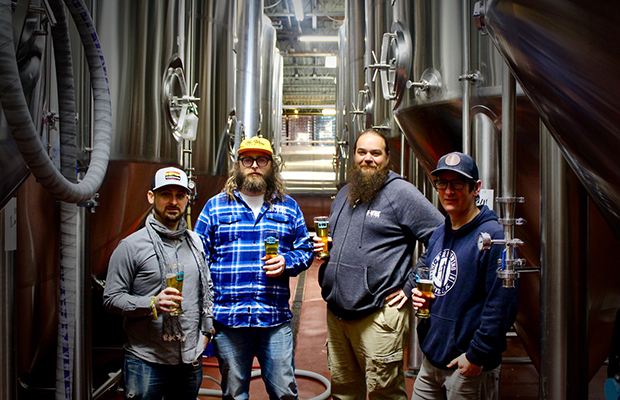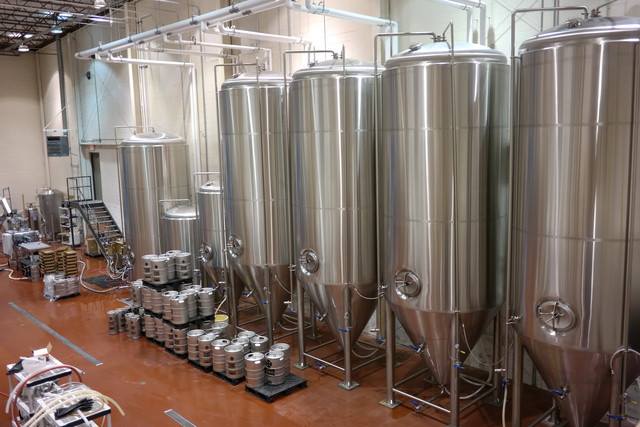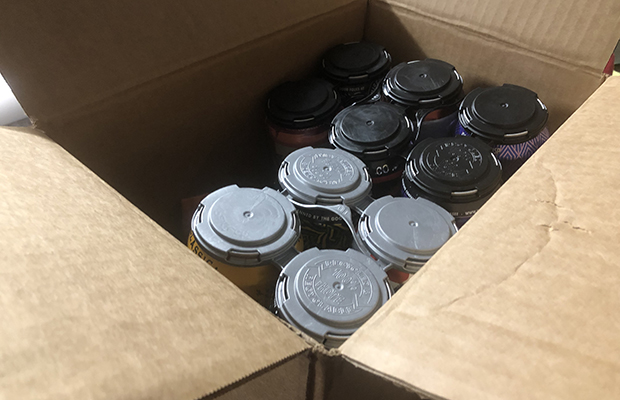
Although IPAs pay the bills, the heartbeat of Hi-Wire is Lagers.
The Asheville, North Carolina brewery — founded by Adam Charnack and Chris Frosaker in 2013 — saw Lagers as the niche the brewery could grow from. Although it’s not the top-selling style of beer, it’s still a gateway to growth for the facility.
The morning of the brewery’s annual North Carolina Small Batch Festival in early March, the brewery was just about to put eight new fermentors online to help boost production in anticipation of launching into Virginia in mid-April. As members of the brewery set up last-minute touches such as parking, token collection, roping off areas for consumers to stay out of in the brewery’s 27,000 square-foot warehouse that houses both production and a tasting room, Charnack and Frosaker sat down with Brewer to discuss the hole they saw in the market in 2012 to capitalize in Asheville; how Lagers helped build the brand at first; and how expanding away from North Carolina has been a surprising success for the brand.
“I think Lagers, and the beer Hi-Wire Lager, is kind of the core of who we are,” Frosaker said. “It takes a long time to make, it’s finicky. But we do it right. And we’re patient with it. It’s a 6-8 week beer every single time and that particular Lager has blossomed into two different things that exist today.”
Luke Holgate, Hi-Wire’s head brewer, is a big ‘Lager nerd,’ Frosaker said.
“He’d brew Lagers all day if he could,” he said with a laugh.
That has become two roads of Lagers for the brewery as Holgate heads up a local Lager program where he can be creative and diverse in the category.
“He does a lot of one-off Lagers that we can, using typically North Carolina malts,” Frosaker explained. “We’re fortunate enough in North Carolina to have three or four different malthouses here.
The brewery has even worked locally with Riverbend Malthouse to create custom malts for these releases.
Now, North Carolina is home, but the duo loves to reconnect in new ways with their home state. The debut of Old North Premium Lager in 2019 is that way. Under the banner of Old North Beer, Hi-Wire launched a high-quality, low-price point Lager made with all North Carolina ingredients.
“North Carolina is known as the Old North State,” Frosaker said, “and North Carolinians are proud of that and proud of that term.
“Craft beer obviously has grown a ton. But clearly, we’re not hitting everybody. Big macro Lagers are still the bulk sold in this country. Mic Ultra is growing like crazy. It’s kind of our way to both dig in deep into our local market — we consider all of North Carolina our local market — as well as hitting that kind of price-conscious consumer that wants a really well-made American Lager. I always see it as, if an account isn’t appropriate for Hi-Wire, that’s the Old North target.”
Frosaker thinks what Lagers do is build respect for the brand among those that know craft beer.
“Beer nerds, people who know beer and know how beer is made, can see that we can do a number of types of different Lagers really, really well and I think it speaks loudly for the quality of our brew staff and what we knew,” Frosaker said and Charnack agreed.
“It’s 100% barley, there’s no corn adjunct or anything like that,” he added. “That’s something I’m proud of is that we’re able to hit that price point, hit that consumer, but also stay true to who we are.”
The mainstay Lager was a leader coming out of the gate when the brewery opened its first location in June, 2013, taking over the former Craggie Brewing Company location in November, 2012.
“We just couldn’t make enough when we started so it never had a chance,” Frosaker lamented. “But also, a lot of the craft market then — and still is — are very, very IPA-driven. So we were able to be nimble. We really kind of refocused on IPAs.”
Now, the brewery focuses on four year-round IPAs with High Pitch Mosaic being its top seller.
With neither Frosaker nor Charnack having a brewing background, they relied heavily on Holgate out of the gate. Holgate has been a cellarman at Craggie and joined the Hi-Wire team when Charnack and Frosaker took over.
“He was really young, really creative, and had a strong science background,” Frosaker recalled, noting that the original head brewer job was offered to someone else first, but that person took a job at Oskar Blues instead.
“He was like, ‘Guys, I can’t turn this down. Just talk to Luke,’” Frosaker said . “We talked to Luke and had Luke brew us a beer just as a job interview. He made the first version of what is now our best-selling seasonal, Strongman Coffee Milk Stout. We hired him on spot.“
Charnack felt that the duo lucked out a bit because they were able to take over a brewery space instead of having to build from an empty room or from the ground up. With an SBA loan and some tweaks to a wonky old brewhouse (which was on its third owner since it was the original brewhouse of Highland Brewing) that was very manual, the brewery opened up fairly quickly.
“We are not envious of people who have to start from scratch,” he said. “That learning curve would have been enormous and the mistakes we would have made inevitably. So having a brewery there, a trench drain, tanks, glycol run … everything pretty much there.
“We added a mill but 90% of it was turn-key. We did the taproom, which was kind of our creative outlet in the space but I don’t envy people who have to do it from scratch.”
Frosaker was a pharmacist by trade while Charnack was developing affordable housing.
“We wanted a little bit of a career change,” Frosaker said. “Both wanting to start our own business and the space just fell into our hands in a way just kind of unheard of. We were out to dinner with some friends one night and they said, “Hey you know, Craggie is for sale and next thing you know we’re in there poking around and crazy enough … we bought the place.
“We were lucky enough to walk into an already completed brewery. It had a lot of quirks. It was far from perfect but it was set up and we were able to make really high-quality beer from Day One.”
It was a 30-barrel, two-vessel brewhouse made out of dairy tanks on direct fire. They would brew four times a week on average just one turn per day.
“It was a lot of liquid at once but it was extremely manual,” Frosaker said. “Your hand-raking out thousands of pounds of grain out of a horizontal lauder tun.
“We learned a lot about what not to do really, just kind of working on that system for a few years.”
The brewery started in bottles for retail quickly, seeing that at the time the only locals doing that were Highland and Asheville Brewing.
“Now it’s you can’t even open up a brewery without canning now,” Frosaker quipped of the area. “We actually opened our doors doing those two things: making a high-quality Pilsner and bottling. We bottled 12-ounce six-packs for grocery store distribution from the day we opened, which now is commonplace, but back then it kind of turned some heads.”
And Hi-Wire is an oddity in pushing retail as well, reaching as far away as Ohio for distribution in a now eight-state region with Virginia coming online most recently.
“They always talk about if you want to go deep, or do you want to go wide and our strategy has really been a little bit of both,” Charnack said. “We’re going to keep growing in our core markets, which we’ve been successful doing. Our top seven wholesalers were all up last year, almost all of them by double digits. So we continue to grow in our local markets and our more established markets while also finding new customers.”
The real experiment was Ohio, he admitted.
“Our brand was in North Carolina, South Carolina, Tennessee, and Georgia at the time, and a wholesaler from Ohio came to us and said, ‘We like your brand.’ We didn’t know if we should be selling our beer in Toledo and Cleveland, but we went up and visited them.
“We said let’s give it a shot and see what happens, and it’s now our third largest wholesaler.”
Charnack said that kind of success away from home has emboldened Hi-Wire to open up some other states, like Virginia.
“If our brand is resonating outside our core region, I don’t see a reason as to why not spread the word out there,” he said. “The fact that somebody in Cleveland or Toledo or Cincinnati or Columbus or anywhere in Ohio is buying our beer and it’s working, it kind of makes us have confidence that we’re onto something. Let’s keep getting it out there and see how it goes.”
Hi-Wire may be the only Asheville connection to a beer buyer in Ohio, for instance, so it opens up a gateway to connect with a consumer on that level as well since the region is such a craft beer-centric area.
“Asheville is a huge tourist town, a lot of natural beauty, great food, great beer, and people come to Asheville to have a really good time,” Frosaker said. “Wherever Asheville is a ‘thing’ outside of town, that’s kind of where we’re looking. Ohio is a great example.
“There are people from Cincinnati coming down in droves to check out Asheville for a weekend. It’s an easy drive. They respect the beer scene down here. So wherever Asheville is relevant is something that we try to capitalize on.”
Working with the regional chamber, Hi-Wire can track overnight visitors and where they are from. They have looked at POS systems that can track where purchases in the taproom are from, but they have not pulled the trigger on that effort yet.
“We just don’t like the idea of that barrier between us and our consumer, we want to make it as seamless as possible where you want to buy a beer,” he said about asking to scan an ID at the time of purchase. “Here’s five bucks and a beer, make it something simple.”
By the summer of 2015, a move was needed and the Big Top production facility was born. Already using the debt finance model, the brewery made a purchase 10 times the amount of the original loan to open Big Top in the Biltmore area of Asheville.
“We really still believe we wanted to be in town,” Frosaker said. “A lot of breweries when they go build their mega dream … you end up out in the country, you’re almost kind of forced to do it because that’s where you can find space or cheaper real estate or a big existing warehouse building. We wanted to stay in town.
“If you look at a map of Asheville, we’re right in the middle of town, which is exciting. A lot of traffic coming through here. And we also like older buildings. If you look at all of our real estate right now they’re all rehabbed old buildings. We don’t have a single new building in our real estate.”
Along with the two Asheville locations, Hi-Wire opened up retail taprooms in Durham in December, 2018 and Knoxville, Tennessee in July, 2019.
“Those are wonderful things for our brand, both financially as well as just brand health/brand awareness,” Frosaker said. “People can come in and experience us in different markets. Not every distributor is going to carry every beer that we make … hundreds of different beers a year.
“So people can come in and get fun one-offs, small-batch stuff, but they can also get High Pitch IPA super fresh instead of just at the grocery store market. It’s been very good for us.”
Not brewing on-site was intentional as well.
“We think we can make the best beer possible here in this building,” Frosaker said of the Big Top facility. “We kind of worry about quality if we were to branch out too far. We really want to control our quality of what’s coming out of the building here.
“Also, just kind of selfishly, it’d be really hard to manage. It’s hard enough to manage our retail locations several hours away, but raw materials and brewers and boilers going out and all that kind of stuff. So we really found a good way to simplify it where the space feels awesome. It’s the best quality beer we could make. Each taproom is getting different one-offs weekly, coming out of Asheville here and we’ve kind of found a good balance of a space that feels good, but we don’t need a brewhouse in there.”
Charnack feels that Hi-Wire has found the right hybrid model of wholesale and on-premise that’s working for the brand.
“Having a taproom in downtown Asheville, we started out distribution focused, and the Durham opportunity kind of developed organically,” he said. “Somebody talked to somebody and recommended something to us and then we took a look. One thing led to another and it just made sense.
“It was definitely a big risk and a big gamble. But we saw that it was successful financially.
The Durham market, which is the second oldest market for the brand outside of Asheville, grew more than 23%.
“A very old, established market for us growing 20 plus percent? That speaks volumes as far as I’m concerned,” Charnack said. “A big part of that is having a local presence there and showing people in the community that you’re committed to them and that this is a community we want to be a part of. We host music series, we host events, we, we do nonprofit nights. That’s the whole idea of a craft brewery taproom, to be that community third space where people come together and hang out and see their neighbors and all that kind of stuff.”
Charnack did joke that year with the Hi-Wire business model is they go through a whole planning process by June or July.
“By mid-year, we have all of our beers for next year and we say, ‘This is the plan, we reserve the right to change as much as we want.’ And then pretty much a month later, it’s changed,” he said with a smile. “It’s not a matter of fickleness or changing your mind. It’s just you have to be adaptable.
“In what other industry is there 8,000 — I hate the word competitors — but 8,000 fellow breweries or fellow companies? You don’t see that in like, potato chips or sodas. And those are competitive industries, but there’s a lot of people out there. So I think you have to think ahead constantly and try to find how you think you can differentiate yourselves and be flexible in both.”






Be the first to comment